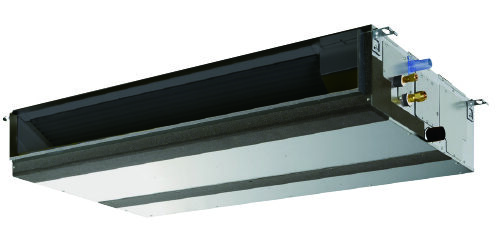VRF Air conditioners for work place
VRF Airconditioning Systems
Variable Refrigerant Flow Air conditioners, abbreviated as VRF is comparatively a recent entry to the industry of comfort air conditioning. Combining advanced microprocessors to finely control the refrigeration cycle is that make VRF outstanding from the other alternatives of comfort air conditioners.
Cooling Demand based on Peak conditions
Below are the factors affecting Cooling demand for an air conditioned work space
- Ambient temperature and the amount of air induced to indoors
- Intensity of solar heat and the building envelope containing walls, windows, roof etc.
- No of people, nature of work, comfort condition settings etc
- Heat generation from equipment, lights and other sources
Looking at the above it can be seen that each of them individually and all of them collectively are transient in nature. HVAC equipment selection is made for the estimated maximum demand based on available annual statistics of weather data pertaining to the locality where the air conditioning is done.
Capacity Control:
Where ever a variable output is expected of from an equipment, capacity control is a requirement. On vapour compression refrigeration cycle which is the technology widely used for cooling equipment, switching off the compressors through the control circuit is the mechanism used for capacity control. Control logic used were widely different and innovative across commercial products to normalise the variation of temperature during the off and On cycles and to improve the energy efficiency. VRF has simultaneously solved many such problems with the use of microprocessors and variable frequency drives to accurately control the capacity to just match the instantaneous cooling demand.
In addition to giving capacity controls, due to the inherent principles of thermodynamics and heat transfer, VRF systems features higher energy efficiency during part load conditions.
Technology:
Compressors are the pumping devices of every vapour compression cycle. Compressors are of various types. Scroll compressors are widely employed these days for cooling capacities from 3 TR and above for commercial air cooled packaged air conditioning systems. Anyway in every form of compressor, the speed of rotation of the compressor has a direct relationship with the amount of refrigerant being pumped. Lower rotation speed (say rpm) reduces the pumping and vice versa.
Variable Frequency Drives are used to vary the driver motor speed to achieve this change. VFDs with control signals from the microprocessors , maintain the exact rpm to the match the refrigerant flow demand for the load at each time.
General Arrangements
VRF systems as like other Vapour compression cycles has a condensing unit. The condensing unit will draw refrigerant vapours at low pressure and will deliver liquid refrigerant at high pressure. For this a pair of refrigerant piping is connected between the condensing units and the cooling units inside. The attraction is that with a single pair of refrigerant piping, multiple indoor units and condensing units can be connected. The indoor units can be of any type and are typically Cassette type, wall mounted splits, Low static ceiling suspended units, High static ductables, Floor mounted types etc.
Due to the flexibility of combining and splitting with micro processor based controls, VRF offer a wider flexibility to the designer.
Links to catalog for some VRF products available commercially are enclosed below.
https://www.jci-hitachi.com/outdoor/hptypes_ns-npseries/pdf/brochure.pdf
https://www.mitsubishielectric.com.au/assets/LEG/MEE10K026_CM11WD_I_w.pdf
